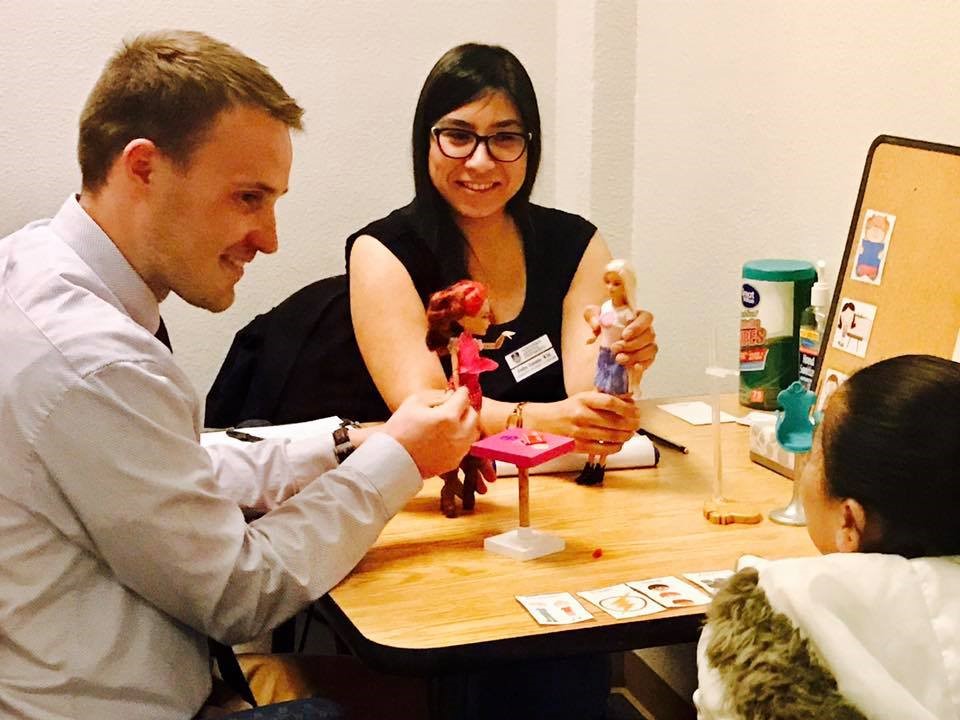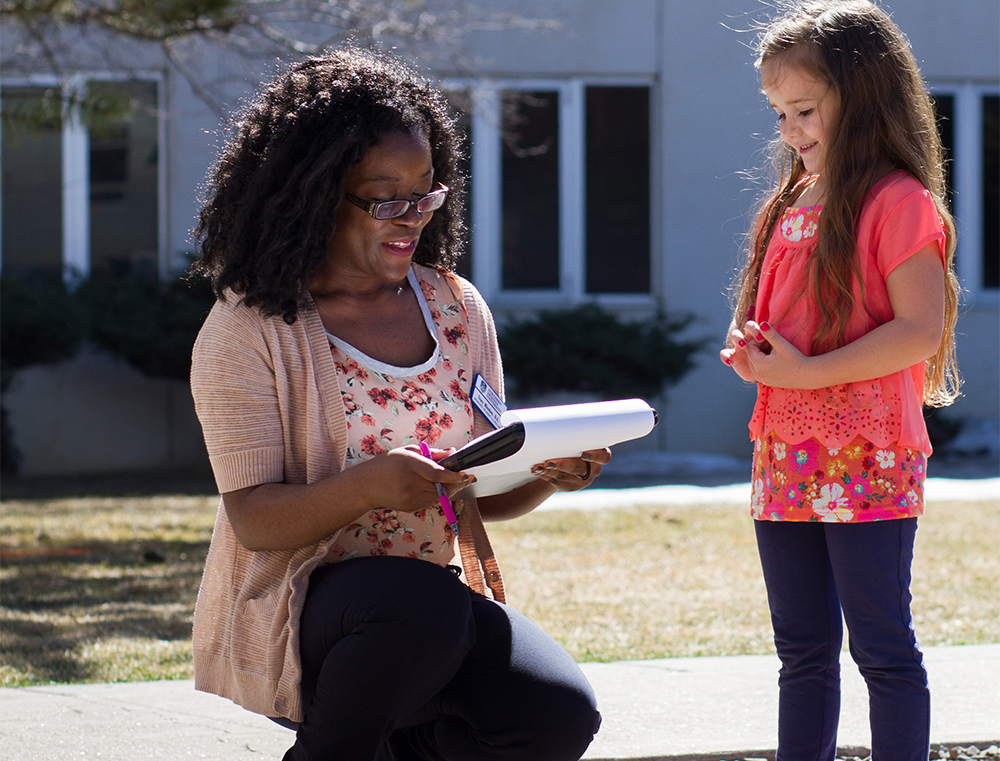
By Heidi Toth
NAU Communications
Fe Murray looked at the boy’s face as she walked into the room. She’d been told he was shy, that he had behavioral problems, that he wouldn’t talk to her, that he was uncommunicative and didn’t connect much with others. The look on his face testified at least to that last part.
She started talking, and everything changed. As she spoke to the boy in Spanish—the language she learned at home, the language he learned at home, the language of their shared history and culture—his eyes brightened, he smiled and he talked to her.
The more they talked, the more Murray, a professor of speech language pathology at Northern Arizona University, realized what was wrong, what had gone unnoticed for years. The boy in front of her, despite going to an English-speaking school for two years, was having trouble learning a second language because he struggled with his first. He could speak and understand social Spanish, the words his family and his community spoke to him, but he had a communication disorder that left him without a foundation. Without truly understanding the rules of his native language, he had little hope of successfully picking up a second language without intervention.
With few bilingual speech language pathologists in northern Arizona, that disorder had gone unnoticed until Murray and her team of graduate students walked into his school. Murray is a bilingual speech language pathologist, and in fall 2016 she began training graduate students to diagnose and treat bilingual students. She knew there was a need, but even she was surprised how many school administrators from the surrounding communities called for their services and what a difference it made to the children.
“What they’re going through is often very lonely,” Murray said. “They’re in a place where no one speaks their language and they’re having a hard time learning a second language possibly because they have a disorder in their primary language. They may not really be all that shy. They just have no way of communicating.”
The intersection between learning English and speech disorders
Speech and communication disorders range from lisps, stuttering and speaking with an unusually high pitch to lack of reading comprehension and not understanding how to form sentences. Speech disorders like lisps may be fairly noticeable. Communication disorders, like not understanding pronouns or not knowing how to put together a sentence, can be harder to detect.
Without straight answers, speech pathologists have created a screening protocol—questions to ask, steps to take, indicators to observe—that allow them to identify these disorders. Murray said these generally pinpoint students suffering from one of these disorders.

Those protocols, however, were designed by English-speaking pathologists for English-speaking students according to the rules of English. A second language adds many complications.
Master’s student Matt Richardson discovered those complications early. He was a bilingual elementary teacher before making a career change to speech-language pathology and was part of the bilingual evaluation team in the fall. He’s become a much bigger advocate for culturally and linguistically appropriate services since seeing the struggle English language learners have.
“There is a steep learning curve when it comes to evaluating and treating speech and language disorders in a second language,” he said.
The intersection between learning another language and speech and communication disorders is difficult to navigate because sometimes the normal hardships of learning English as a second language mimic the symptoms of a disorder, while other times a disorder is written off as the normal difficulties of learning another language.
Many potential pitfalls exist in the assessment process. For example, not every language has the same sounds. In Spanish, the letter “R” makes a different sound than the English “R.” That sound doesn’t exist in Navajo or some Asian languages.
“If the child can’t produce a particular sound when they’re trying to speak English, is it because they have a disorder or is it because it doesn’t exist in their first language?” Murray asked.
Another example is in sentence structure. In English the adjective precedes the noun: white house. In Spanish the noun comes first: casa blanca.
“If a child is learning English and says, ‘I live in a house white,’ is that because of the second language influenced by the primary language, or is he having difficulty with syntax?”
Those differences stood out as Richardson tried to distinguish a communication disorder from normal English language learning.
“It is absolutely critical to assess and treat a child in his or her primary language,” he said. “It’s very easy to misdiagnose a child with a disorder, when in fact his or her speech and language characteristics are due to cultural or linguistic differences.”
NAU’s bilingual speech-pathology team
The team was made up of three students each semester in the 2016-2017 school year, all master’s students in the communications and speech disorders program. Some were bilingual; others spoke only English and worked with an interpreter. Assessments took place entirely in Spanish or were a mix of English and Spanish, depending on the child’s comfort level.
With the exception of the interpreter, the process looked similar to the assessment of an English-speaking child. The team plays a couple of games and asks questions, starting with easy answers and getting more involved as the conversation goes along, while still working to keep the child at ease. They give formal assessments and make informal observations. The entire session is recorded.
Once the session is complete, all the students and Murray listened to the recording, making notes of dozens of criteria: the number of English words used, the number of Spanish words used, the sounds the child used, basic understanding of the questions, the ability to retell a story sequentially using appropriate vocabulary and grammar, the pitch of the child’s voice, possible stuttering and more.
They also talk to the child’s teacher and parents. A child may speak a different dialect at home, resulting in speech patterns that are not used in a standard form of the language but don’t mean the child has a problem. He or she may “code switch”—weaving English and Spanish together, switching from one to the other mid-conversation or listening in one language but answering in another.
Armed with that data, the team members discuss what’s wrong and what action to recommend to the school district. The child may simply be struggling through the process of learning a new language, in which case intervention from a speech-language pathologist is unnecessary. The child may not have a disorder but may be struggling more than expected to learn English, in which case more effective ELL programming may be recommended.
Or, as in seven of the 10 students they worked with this year, the child has a speech or communication disorder and needs services, which they can receive through the school district or the department’s clinic.
“That’s what we’re trying to find out,” Murray said. “Is it a disorder, or is it a difference? We don’t want to label someone as being disabled in communication when really what they are exhibiting is just a normal part of learning a second language. But we also don’t want someone who’s learning a second language and struggling with their first language to not be identified because a speech-language pathologist doesn’t speak the language to assess them in or because they think it’s a second language thing.”

Hearing success
For one student, speech therapy was among the highlights of her week.
“She absolutely loved it because it was the first time she’d ever received speech or language services in Spanish,” Richardson said. “We had to start with basic oral narration and phonemic awareness, but she made a ton of progress and was excited to continue therapy this summer.”
Murray had a student who’d been tested in preschool and diagnosed with a disorder. When he entered first grade, his school had him retested by Murray’s team.
“It turned out that he wasn’t disabled; he had been misdiagnosed,” she said. “He was in that typical learning-two-languages mode. It was really nice to dismiss him from therapy services as a child who was typical.”
Success for Murray is properly identifying children and getting them the help they need, be it therapy, extra help with English or just the understanding that learning a new language is hard and takes time. But for her it runs deeper. As a native Spanish speaker who still speaks Spanish with her family, even though her mother and sisters are fluent in English, she recognizes that for many of these children, Spanish connects them to their heritage. Children with a learning disorder may not only have a hard time learning English, so they may not have a solid grasp on more than conversational Spanish, which puts them at risk of not being able to communicate meaningfully with their communities.
For that reason, she never tells parents to stop speaking Spanish to their children. Rather, she tells them to raise the level of their Spanish: read difficult books, ask questions that require complicated answers, demand a higher level of language. But speak the language of home. If that means children “code switch” between English and Spanish or learn more informal language, that’s OK.
“They lose their culture and their link to their family when they lose fluency in their home dialect or their home language,” Murray said.



